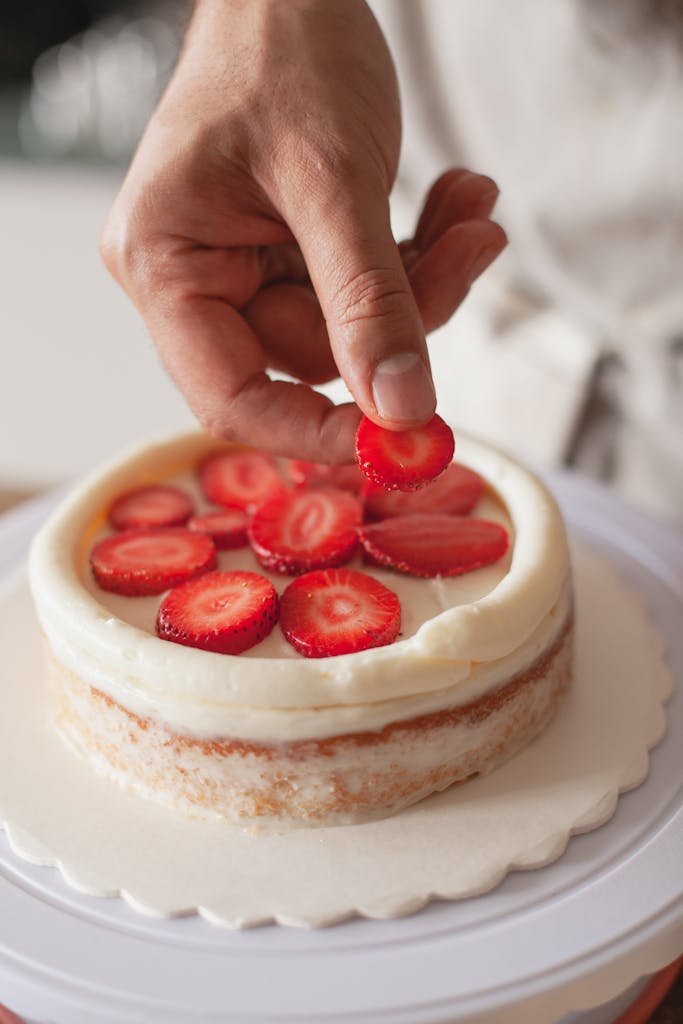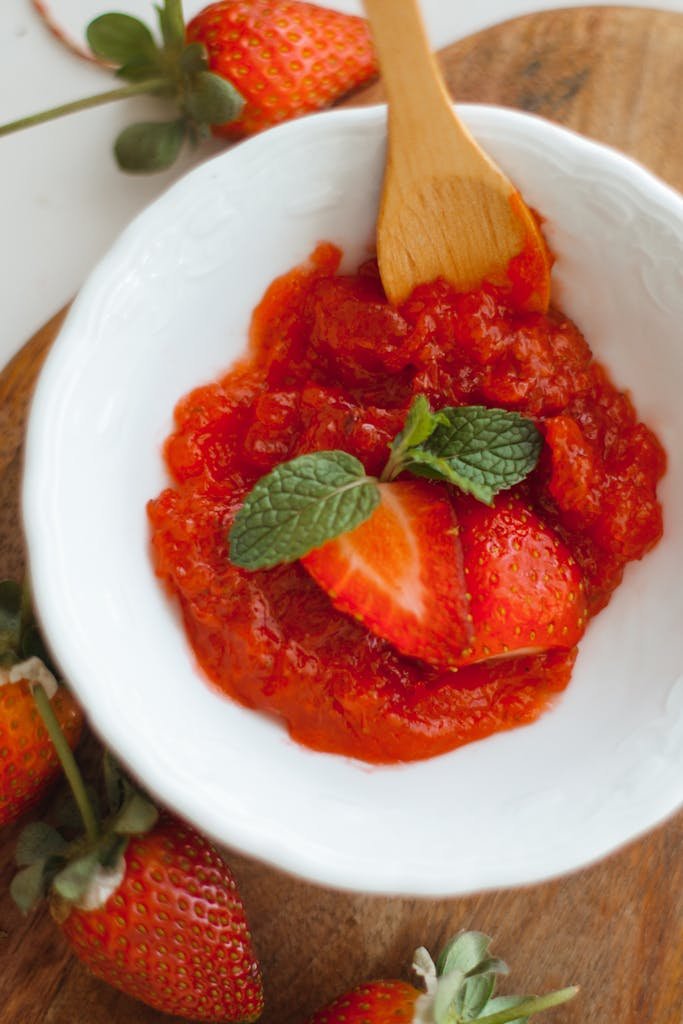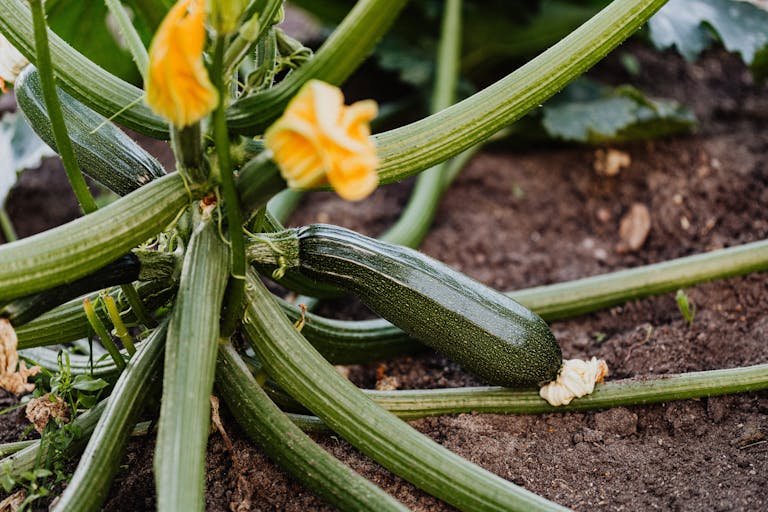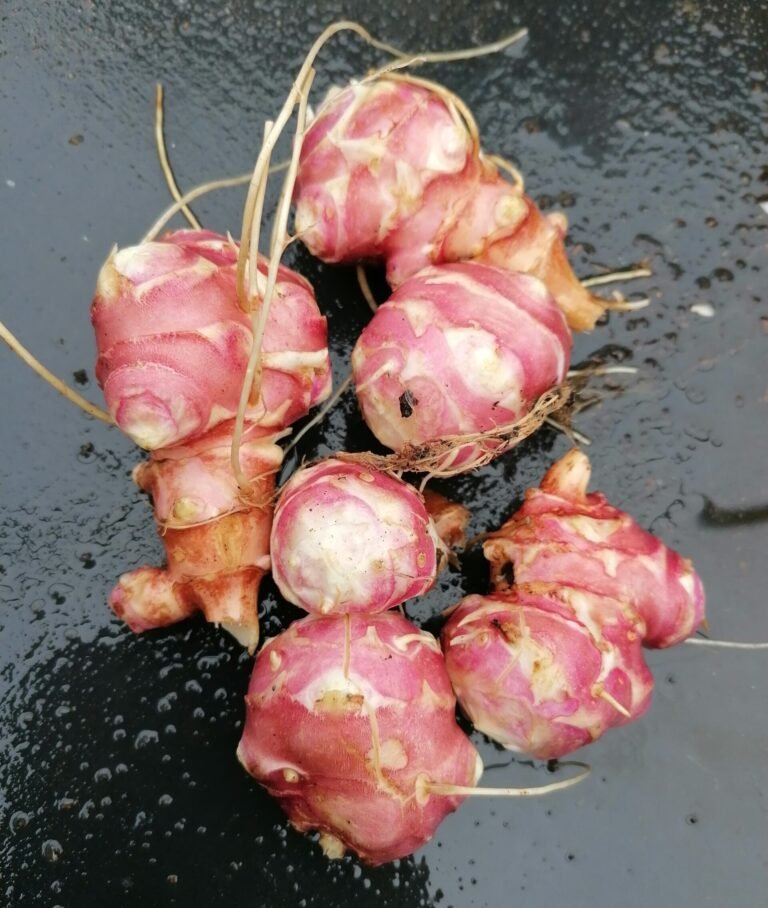
It feels like something out of a storybook when you grow strawberries in hanging baskets. Ruby-red berries dangling from cascading vines, ripening in the sun, just waiting to be plucked. Before Gar built the strawberry towers, every last one of our berries thrived in hanging baskets, swinging above the garden beds like tiny chandeliers of sweetness. It wasn’t just about saving space—though that was a bonus—it was about keeping those precious fruits safe from slugs and muddy splashes. It gave them the best chance to ripen to perfection.
If you’re working with a small garden, a balcony, or just want to add a touch of charm to your outdoor space, growing strawberries this way is a game-changer. But there’s a bit of an art to it—choosing the right variety, getting the soil mix just right, and keeping your baskets hydrated without drowning your delicate plants.
Luckily, after years of growing strawberries, I’ve learned the tricks to maximizing harvests while keeping the plants happy. Whether you’re a first-timer or a seasoned gardener, this guide will take you through everything you need to know—from selecting the best hanging basket varieties to keeping them thriving all season long. And if you’re ready for the full deep-dive into strawberry-growing magic, don’t forget to check out my Complete Strawberry Growing Guide for everything from runners to winter care.
Now, let’s get those baskets brimming with berries!
Some of the links in this post are affiliate links, including links to products on Amazon. This means if you click and make a purchase, I may earn a small commission at no extra cost to you. I only recommend items I genuinely love and believe could add value to your life. Thank you for supporting this blog
Why Grow Strawberries in Hanging Baskets?
Before Gar built the towers, our strawberry plants lived high above the garden beds, nestled in hanging baskets like little suspended fruit farms. And let me tell you, it wasn’t just about saving space—it was about giving our berries the best possible home. There’s something almost magical about seeing vines cascade over the edges, delicate white blossoms giving way to blushing berries that dangle just within reach.
But beauty isn’t the only reason to grow strawberries this way. Hanging baskets solve some of the biggest strawberry-growing woes:
✅ Perfect for small gardens, patios, or balconies – No sprawling garden? No problem! Hanging baskets let you grow lush, thriving strawberries even if all you have is a sunny wall or a little balcony space. (Check out this set of sturdy hanging baskets that work beautifully for strawberries.)
✅ Reduces pests and soil-borne diseases – Keeping your berries off the ground means fewer slugs, less rot, and a whole lot less heartbreak. Plus, good airflow keeps disease at bay. (I love using self-watering hanging baskets for an extra hydration boost!)
✅ Easy to maintain and harvest – No more bending, crouching, or rummaging through leaves. Just reach up, pluck a sun-warmed berry, and pop it straight into your mouth. (These extra-large hanging baskets hold plenty of plants for bigger harvests!)
✅ Creates a beautiful, cascading display – Because who says practical can’t be stunning? Whether trailing from a pergola or brightening up a dull fence, a basket bursting with strawberries is pure garden eye candy.
Hanging baskets turned our strawberry-growing dreams into a reality, and I have no doubt they’ll do the same for you. Now, let’s talk about how to set them up for success!
Best Strawberry Varieties for Hanging Baskets
When it comes to growing strawberries in hanging baskets, everbearing and day-neutral varieties are hands down the best choice. Unlike June-bearing strawberries, which give you one big harvest and then call it a day, everbearing and day-neutral types keep producing fruit throughout the season. That means fresh, juicy strawberries from late spring through autumn—without the mad rush to pick them all at once. Plus, they tend to be more compact, focusing their energy on fruit instead of sending out endless runners, which makes them ideal for a hanging display.
🍓 Albion
A firm favorite among home growers, Albion produces large, sweet berries with a deep red color. As a day-neutral variety, it fruits consistently from late spring to autumn, giving you a steady supply of strawberries rather than one fleeting harvest.
🍓 Seascape
If you love strawberries with a bold, sweet-tart punch, Seascape is your best friend. Another day-neutral variety, it thrives in hanging baskets because it’s compact, fuss-free, and generous with its fruiting. Plus, it’s heat-tolerant, making it a great choice for warmer climates.
🍓 Temptation
The name says it all. This compact, runnerless variety is practically designed for hanging baskets. It puts all its energy into producing deliciously juicy berries rather than sending out endless runners, meaning more fruit and less maintenance.
🍓 Mara des Bois
If you’ve ever wanted strawberries that taste like they came straight from a French summer garden, this is the one. Mara des Bois is famous for its intense, wild-strawberry flavor. It’s everbearing, meaning it fruits repeatedly throughout the season, and its cascading habit makes it look stunning in a basket.
🍓 Elan
A vigorous grower with an impressive fruiting habit, Elan is perfect if you want an abundant harvest. It’s packed with extra vitamin C compared to other varieties and has a wonderfully aromatic sweetness. It also produces berries a little earlier than most, giving you a head start on summer snacking.
Each of these varieties thrives in a hanging basket, keeping your strawberries safe from slugs while turning any corner of your garden, patio, or balcony into a lush, cascading berry haven. Now, let’s talk about setting up the perfect basket!
Choosing the Right Hanging Basket and Location
Picking the perfect hanging basket for strawberries isn’t just about looks—it’s about giving them the best shot at a lush, fruit-filled season. The wrong setup can lead to dry, struggling plants or berries that never reach their full, sun-ripened sweetness. But get it right, and you’ll have cascading vines, vibrant green leaves, and ruby-red fruit just waiting to be plucked.
🍓 Basket Size & Material – Strawberries need space to stretch their roots, so go for a basket at least 12 inches (30 cm) wide. Wire baskets with coconut coir liners offer great drainage and airflow, while plastic baskets retain moisture, making them ideal for hot, dry climates. For a balance of function and charm, ceramic or woven baskets with drainage holes work beautifully.
🍓 Drainage: Why It Matters – Strawberries hate soggy roots, so pick a basket with plenty of drainage holes. If using a liner, poke a few extras to keep water flowing smoothly.
🍓 Sunlight & Placement – Strawberries are sun lovers, thriving with 6–8 hours of direct sunlight. A south- or west-facing spot is ideal, and a hanging bracket hook (Amazon link) lets you adjust placement as the seasons shift.
🍓 Protecting Against Wind & Heat – Hanging baskets dry out quickly, especially in strong wind. A sheltered spot near a fence or wall helps, and in extreme heat, a little afternoon shade prevents scorching.
Get these details right, and your strawberries will reward you with a season of sweet, sun-kissed berries. Now, let’s get those baskets planted!
The Best Soil Mix for Hanging Basket Strawberries
Strawberries are picky about their soil—too heavy, and their roots suffocate; too light, and they dry out in a heartbeat. In hanging baskets, where moisture levels fluctuate faster than in garden beds, getting the soil mix just right is key. A well-balanced blend will keep your plants thriving, producing sweet, plump berries all season long.
🍓 The Ideal Soil Composition – The perfect strawberry mix is light, well-draining, and nutrient-rich. A standard garden soil is too dense for baskets, so you’ll need something airy enough to prevent compaction but rich enough to support continuous growth. Think of it as a cozy yet breathable bed for your strawberry roots.
🍓 DIY Potting Mix Recipe for Optimal Growth – If you want to mix your own, try this blend:
- 2 parts high-quality potting soil (peat-free if possible)
- 1 part compost (for slow-release nutrients)
- 1 part perlite or vermiculite (for aeration and moisture retention)
- A handful of worm castings (your strawberries will love you for this!)
🍓 The Role of Compost & Perlite – Compost feeds the soil and improves water retention, while perlite or vermiculite keeps everything aerated so roots don’t drown. If you’re using a store-bought potting mix, look for one labeled for fruits and vegetables or amend it with extra compost.
🍓 pH Levels & Adjustments – Strawberries prefer a slightly acidic soil, around pH 5.5–6.5. If your mix is too alkaline, a sprinkle of sulfur can lower the pH. If it’s too acidic, a bit of garden lime will balance things out.
Get this mix right, and your strawberries will have the perfect home—fluffy, fertile, and moisture-balanced. Just one step closer to basketfuls of juicy, homegrown berries! 🍓
How to Plant Strawberries in Hanging Baskets
Planting strawberries in hanging baskets isn’t just about tucking plants into soil—it’s about giving them the best start for months of effortless picking. A little care now means a lush cascade of green leaves and juicy berries later.
🍓 Step-by-Step Planting Guide – Choose a deep, 12-inch-wide basket to give roots space. Fill it with nutrient-rich potting mix, leaving an inch at the top for watering. Plant 3–5 strawberries per basket, spacing them 4–6 inches apart for airflow and growth. For extra berries, a grow bag maximizes space.
🍓 Root Positioning Matters – Burying roots too deep causes rot, while planting too shallow leads to drying out. The crown (where leaves emerge) should sit at soil level. If using bare-root plants, gently spread the roots instead of cramming them in.
🍓 Watering Wisely – Hanging baskets dry out faster than garden beds, so consistent moisture is key. After planting, water deeply but gently. If you tend to forget watering, a self-watering basket can help.
🍓 Mulching for Moisture & Clean Berries – A light layer of straw, shredded leaves, or coconut coir locks in moisture, prevents soil splash, and deters weeds—keeping berries clean and pest-free.
With the right planting technique, your hanging baskets will soon be brimming with lush foliage and sweet, sun-ripened strawberries, ready for easy picking from your porch, patio, or balcony!
Caring for Your Hanging Basket Strawberries
Growing strawberries in hanging baskets is the easy part—keeping them happy and productive is where the real magic happens. With a little care, your baskets will reward you with an endless supply of sun-warmed berries, ripe for the picking.
Watering & Fertilizing
Strawberries in hanging baskets dry out faster than their garden-grown cousins, so consistent watering is key. Aim to water daily in warm weather and every two to three days in cooler months. The trick? Keep the soil moist but not soggy—drooping leaves mean it’s too dry, while yellowing, limp foliage signals overwatering.
When it comes to feeding, strawberries aren’t too demanding, but a little boost goes a long way. A balanced organic fertilizer every two weeks keeps them fruiting like champs. Want to level up? A diluted seaweed or fish emulsion feed once a month gives them an extra nutrient kick for lush growth and sweeter berries.
Pruning & Runners Management
Strawberries love to send out runners—but unless you’re propagating new plants, these energy-draining offshoots need to go. Snip them off as soon as they appear so your plants put their effort into producing fruit rather than multiplying.
Pruning is simple: remove dead leaves and any yellowing or damaged foliage throughout the season to keep plants healthy and airflow strong. This prevents disease and helps the berries ripen more evenly.
Pollination Tips
If your baskets are outdoors, bees and butterflies will happily do the work for you. But if they’re in a greenhouse or tucked into a covered patio, you might need to play matchmaker. A soft paintbrush or cotton swab works wonders—just swirl it gently inside each flower to transfer pollen. Or, give the basket a gentle shake every few days to mimic the breeze.
Want to invite more natural pollinators? Hang your baskets near lavender, marigolds, or borage—all irresistible to bees and beneficial insects. More pollinators = more strawberries.
With the right care, your hanging baskets will keep fruiting all season, giving you handfuls of fresh strawberries—straight from your own little berry haven.
Here’s a little video on what to avoid:
Harvesting and Enjoying Your Homegrown Strawberries
Few things compare to the joy of plucking a perfectly ripe strawberry, still warm from the sun, and popping it straight into your mouth. It’s a little taste of summer, sweet, juicy, and entirely worth the wait. But when’s the best time to pick them? And how do you make that precious harvest last?
When to Pick for Peak Sweetness
Patience is key when it comes to harvesting. Strawberries don’t ripen after picking, so timing it right is everything. Look for berries that are deep red, firm, and fragrant—a good rule of thumb is to wait at least a day after they look ripe for the best flavor. Morning is the best time to harvest, when the berries are still cool and packed with sweetness.
How to Store Fresh Strawberries Properly
Fresh-picked strawberries are best enjoyed within a few days, but if you need to store them, keep them dry and unwashed in the fridge. Line a container with paper towels, spread the berries in a single layer, and cover loosely. Only wash them right before eating to prevent moisture buildup (which leads to mushiness).
For longer storage, freezing is your best friend. Hull the berries, spread them on a tray to freeze individually, then transfer to an airtight container. This keeps them perfect for smoothies, baking, or snacking all year round.
Fun Ways to Use Your Harvest
If you somehow manage to not eat them all straight from the basket, there are plenty of delicious ways to enjoy your harvest:
- Fresh in a summer salad—try strawberries with fresh basil and balsamic glaze for a garden-fresh delight.
- Homemade jam—nothing beats the taste of real, sun-ripened strawberries spread over warm toast.
- Freeze-dried snacks—crisp, intensely flavorful, and perfect for adding to cereal, yogurt, or granola.
- Strawberry-infused water or cocktails—because even hydration should be delicious.
- Sugar-free strawberry cakes-try out these 3 guilt-free treats
With just a little care, your hanging baskets will keep producing handfuls of berries all season long, ready for snacking, preserving, or turning into the best strawberry desserts you’ve ever tasted.
Common Mistakes to Avoid
Even the most enthusiastic gardeners can run into trouble when growing strawberries in hanging baskets. But don’t worry—avoiding these common mistakes will keep your plants happy, healthy, and bursting with berries all season long.
Overcrowding the Basket
It’s tempting to cram as many plants as possible into one basket, but strawberries need space! Overcrowding leads to poor airflow, more disease, and smaller berries. Stick to three to five plants per 12-inch basket for the best results.
Using the Wrong Soil Mix
Regular garden soil is too heavy for hanging baskets—it compacts easily and suffocates the roots. Instead, go for a light, well-draining potting mix with compost and perlite for better moisture retention and aeration. Adding a slow-release organic fertilizer at planting time gives your strawberries a strong start.
Neglecting Drainage and Air Circulation
Strawberries hate soggy roots, so your basket must have drainage holes. If you’re using a coconut coir liner, make sure it allows excess water to drain out properly. Hanging baskets also dry out faster than ground-planted strawberries, so check the soil daily—a deep watering in the morning usually does the trick.
Forgetting to Fertilize Properly
Strawberries are hungry plants, and basket-growing means nutrients leach out faster with frequent watering. A good routine? Feed with a balanced organic fertilizer every two weeks and supplement with liquid seaweed or fish emulsion to encourage strong roots and sweeter berries.
With just a little attention to these details, your hanging baskets will thrive, rewarding you with cascading vines and endless sweet, juicy strawberries all season long.
Conclusion
There’s something truly magical about stepping outside, reaching up, and picking a warm, sun-ripened strawberry straight from your hanging basket. No bending down, no fighting off slugs—just sweet, homegrown goodness, right within arm’s reach. Best of all, you don’t even need a garden to enjoy it.
By simply choosing everbearing or day-neutral varieties, using well-draining, nutrient-rich soil, and staying consistent with watering and feeding, you’ll be setting yourself up for a steady stream of berries from spring right through to autumn. Whether they’re cascading from a coir-lined basket on a sunny balcony or adding charm to a porch or patio, strawberries are a surprisingly easy and rewarding crop for small spaces.
Even better, once you taste your first homegrown berry—eaten fresh off the vine, dipped in cream, whizzed into a smoothie, or tucked into your favorite summer dessert—you’ll quickly see why growing strawberries in hanging baskets is such a joy. It’s not just about the fruit—it’s about the experience.
So, if you’re ready to take the leap and start your own hanging basket strawberry patch, don’t forget to check out our full Beginner’s Guide to Growing Strawberries for tips on varieties, planting, care, and more. Then grab your basket, pick your plants, and let the berry adventure begin!











